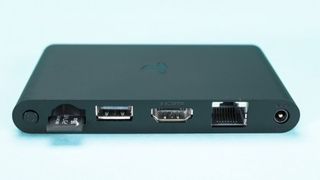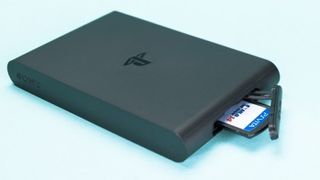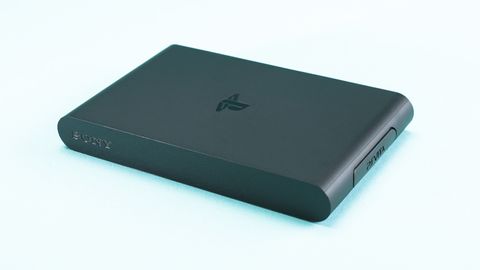TechRadar Verdict
If you're looking for a set-top box, the PlayStation TV isn't it. It works best as a cheap alternative to buying a second PS4 or PS Vita. If you're not in Sony's ecosystem already, this isn't the best place to start, and in most cases does not warrant its $99 price tag.
Pros
- +
PS4 extension
- +
Clean design
- +
Small form factor
- +
Cheapest entry point for PS Now
Cons
- -
No Netflix, Hulu or Amazon apps
- -
Upscaled Vita games look terrible
- -
Borrowed Vita user interface
- -
Broken touchscreen controls
- -
Scarce content
Why you can trust TechRadar
Ask anyone who's been up on stage at a big press event and they'll tell you: It's easy to over-promise and underdeliver. To promise the moon and deliver a telescope.
When I use the PlayStation TV, a micro-console in the same vein as the Ouya or Mad Catz's M.O.J.O., I can't help but feel like I'm viewing the moon through my new $99 (£84, AU$105) telescope.
At best, the PlayStation TV (or PSTV for short) is a bridge between a second TV in your house and the PS4 in your living room, or, as a cheap console for the kids who aren't quite ready for a full-size system.
At its worst, it's a content-bare, set-top box prototype with a recycled interface from the PS Vita and almost no apps, that may - or may not - be cool in another few years.
Design
The PSTV is unbelievably small - it measures in at just 2.6 x 4.1 x .5 inches (L x W x H), which is about the size of a deck of cards or an average smartphone.
Not only is it small, it's incredibly clean too. The front all-plastic panel is free from any button and blemish, while a simple inlaid PlayStation logo is the only marking on the top of the unit. Spin it around to the right side and you'll find a hidden PS Vita card slot. Turn it all the way around to find the clandestine ports.

From left to right, you'll see a 2mm power button, Memory Stick Micro card slot, USB, HDMI, ethernet ports and a 5V battery connector. Everything here feels vital to the operation of the console and while the overall appearance is a bit cramped, it allows the front and sides of the unit to be clutter-free.
Setup
Despite what its 16 x 24 inch quick start user manual may otherwise indicate, setting up the system takes just about five minutes or less if you have your PSN account information on hand.
Syncing up a DualShock 3 or DualShock 4 controller is just as easy. Plug in one end of a mini- or micro-USB into the corresponding controller and the other into the open port on the back of the console. Unfortunately, one of the downsides of the system is that you need a controller and a memory card (that's not sold with the $99 system) for it to work. After you've got a controller connected all you'll need to do is plug in a direct connection to your router or, if a direct line isn't available, connect it to your wireless network.

During the installation you'll be asked to link into an existing PSN account or set up a new one. If you decide to link to an existing account, the PSTV won't necessarily download (or even remember) which games you've bought and installed on a different system, but having one is a necessary evil if you want to download anything on the PlayStation Store.
Interface
If the icon-heavy menu looks familiar to you, you're not going crazy or have ESP (sorry), it's an exact one-to-one translation of the PlayStation Vita's user interface.
While seeing the mobile-friendly interface again makes me nostalgic for my PlayStation handheld, it's a bit of a cop-out. Without the touch controls to poke and prod your way from app to app, you'll be forced to use the control stick to move from one part of the desolate interface to the next in search of something to do.
Sometimes a little innovation goes a long way, and in an already lackluster system the recycled screen just adds insult to injury.
Nick Pino is Managing Editor, TV and AV for TechRadar's sister site, Tom's Guide. Previously, he was the Senior Editor of Home Entertainment at TechRadar, covering TVs, headphones, speakers, video games, VR and streaming devices. He's also written for GamesRadar+, Official Xbox Magazine, PC Gamer and other outlets over the last decade, and he has a degree in computer science he's not using if anyone wants it.


